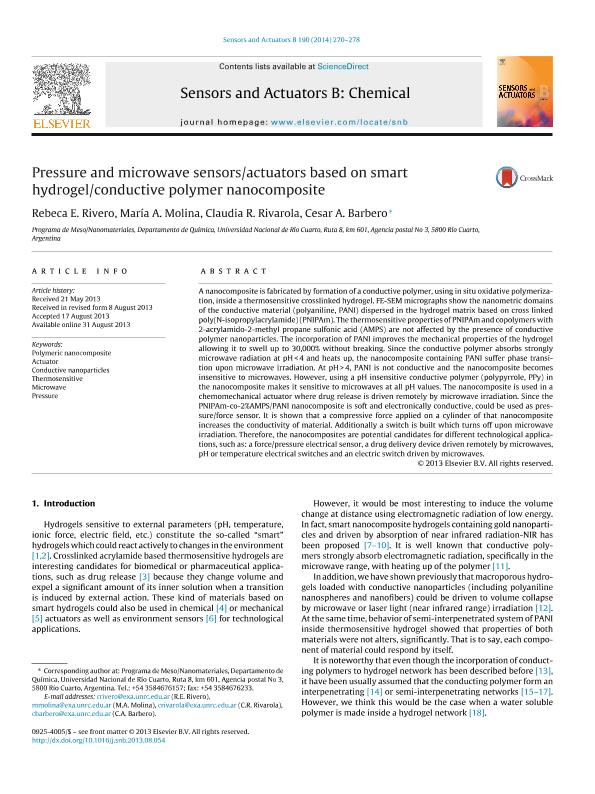Mostrar el registro sencillo del ítem
dc.contributor.author
Rivero, Rebeca Edith

dc.contributor.author
Molina, María Alejandra

dc.contributor.author
Rivarola, Claudia Rosana

dc.contributor.author
Barbero, César Alfredo

dc.date.available
2017-09-27T20:51:37Z
dc.date.issued
2013-08
dc.identifier.citation
Rivero, Rebeca Edith; Molina, María Alejandra; Rivarola, Claudia Rosana; Barbero, César Alfredo; Pressure and microwave sensors/actuators based on smart hydrogel/conductive polymer nanocomposite; Elsevier Science; Sensors and Actuators B: Chemical; 190; 8-2013; 270-278
dc.identifier.issn
0925-4005
dc.identifier.uri
http://hdl.handle.net/11336/25276
dc.description.abstract
A nanocomposite is fabricated by formation of a conductive polymer, using in situ oxidative polymerization, inside a thermosensitive crosslinked hydrogel. FE-SEM micrographs show the nanometric domains of the conductive material (polyaniline, PANI) dispersed in the hydrogel matrix based on cross linked poly(N-isopropylacrylamide) (PNIPAm). The thermosensitive properties of PNIPAm and copolymers with 2-acrylamido-2-methyl propane sulfonic acid (AMPS) are not affected by the presence of conductive polymer nanoparticles. The incorporation of PANI improves the mechanical properties of the hydrogel allowing it to swell up to 30,000% without breaking. Since the conductive polymer absorbs strongly microwave radiation at pH < 4 and heats up, the nanocomposite containing PANI suffer phase transition upon microwave irradiation. At pH > 4, PANI is not conductive and the nanocomposite becomes insensitive to microwaves. However, using a pH insensitive conductive polymer (polypyrrole, PPy) in the nanocomposite makes it sensitive to microwaves at all pH values. The nanocomposite is used in a chemomechanical actuator where drug release is driven remotely by microwave irradiation. Since the PNIPAm-co-2%AMPS/PANI nanocomposite is soft and electronically conductive, could be used as pressure/force sensor. It is shown that a compressive force applied on a cylinder of that nanocomposite increases the conductivity of material. Additionally a switch is built which turns off upon microwave irradiation. Therefore, the nanocomposites are potential candidates for different technological applications, such as: a force/pressure electrical sensor, a drug delivery device driven remotely by microwaves, pH or temperature electrical switches and an electric switch driven by microwaves.
dc.format
application/pdf
dc.language.iso
eng
dc.publisher
Elsevier Science

dc.rights
info:eu-repo/semantics/openAccess
dc.rights.uri
https://creativecommons.org/licenses/by-nc-nd/2.5/ar/
dc.subject
Polymeric Nanocomposite
dc.subject
Actuator
dc.subject
Conductive Nanoparticles
dc.subject
Thermosensitive
dc.subject
Microwave
dc.subject
Pressure
dc.subject.classification
Otras Ciencias Químicas

dc.subject.classification
Ciencias Químicas

dc.subject.classification
CIENCIAS NATURALES Y EXACTAS

dc.subject.classification
Nano-materiales

dc.subject.classification
Nanotecnología

dc.subject.classification
INGENIERÍAS Y TECNOLOGÍAS

dc.title
Pressure and microwave sensors/actuators based on smart hydrogel/conductive polymer nanocomposite
dc.type
info:eu-repo/semantics/article
dc.type
info:ar-repo/semantics/artículo
dc.type
info:eu-repo/semantics/publishedVersion
dc.date.updated
2017-09-27T15:24:38Z
dc.journal.volume
190
dc.journal.pagination
270-278
dc.journal.pais
Países Bajos

dc.journal.ciudad
Amsterdam
dc.description.fil
Fil: Rivero, Rebeca Edith. Universidad Nacional de Río Cuarto. Facultad de Ciencias Exactas Fisicoquímicas y Naturales. Departamento de Química; Argentina. Consejo Nacional de Investigaciones Científicas y Técnicas; Argentina
dc.description.fil
Fil: Molina, María Alejandra. Universidad Nacional de Río Cuarto. Facultad de Ciencias Exactas Fisicoquímicas y Naturales. Departamento de Química; Argentina. Consejo Nacional de Investigaciones Científicas y Técnicas; Argentina
dc.description.fil
Fil: Rivarola, Claudia Rosana. Universidad Nacional de Río Cuarto. Facultad de Ciencias Exactas Fisicoquímicas y Naturales. Departamento de Química; Argentina. Consejo Nacional de Investigaciones Científicas y Técnicas; Argentina
dc.description.fil
Fil: Barbero, César Alfredo. Universidad Nacional de Río Cuarto. Facultad de Ciencias Exactas Fisicoquímicas y Naturales. Departamento de Química; Argentina. Consejo Nacional de Investigaciones Científicas y Técnicas; Argentina
dc.journal.title
Sensors and Actuators B: Chemical

dc.relation.alternativeid
info:eu-repo/semantics/altIdentifier/doi/http://dx.doi.org/10.1016/j.snb.2013.08.054
dc.relation.alternativeid
info:eu-repo/semantics/altIdentifier/url/http://www.sciencedirect.com/science/article/pii/S0925400513009908
Archivos asociados
